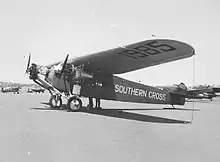Bundjalung Nation Timeline
The Bundjalung people are a large Aboriginal nation, a federation of a number of groups of clans which occupy the land from Grafton on the Clarence river of northern New South Wales north to the town of Ipswich and the Beaudesert, in southern Queensland, and down around the other side of the Great Dividing Range and back to Grafton. In the north, Bundjalung Nation shares a border with Yuggera Nation and Barrunggam Nation; to the east the Tasman Sea (Pacific Ocean); to the south Gumbaynggirr (also known as Kumbainggar) Nation; and to the west it borders Ngarabal Nation.
In pre-colonial times, Bundjalung Nation encompassed some of the richest hunting and fishing grounds anywhere on the Australian continent. According to the oral traditions of the Bundjalung People, these areas were first settled by the Three Brothers and their descendants.
The names of the 15 tribal groups comprising the Bundjalung Nation are Arakwal, Banbai, Birbai, Galiabal, Gidabal, Gumbainggeri, Jigara, Jugambal, Jugumbir (Yugembeh), Jungai, Minjungbal, Ngacu, Ngamba, Nyangbal[1][2] and Widjabal.[3]
The 2007 Githabul Federal Court Native Title Determination which was lodged by Trevor Close a commercial lawyer now living in Perth cut the Bundjalung Nation apart can be viewed here.[4]
To the best of knowledge the Bundjalung Nation Aboriginal people from the East Coast of Australia, the Far North Coast of New South Wales and South East Queensland area, are the only ones whose dream time stories talk about arriving in Australia from elsewhere. They came from the land "at the centre of the world" when a massive catastrophe destroyed it. There are also mobs in Perth region that hold a spiritual belief they are descendants of 'star people' or people from stars & solar system.
Bundjalung Nation Aboriginal people have lived on and visited Goanna Headland for at least 12,000 years. The Aboriginal tribes were not united anytime before the 18th century, with more than 20 main groups, known collectively as the 'Bundjalung Nation'. Certain deities and religious practices were specific to certain localities.
Goanna Headland is also significant as the site where the ancestors of the Bundjalung people arrived by sea and populated the surrounding country. This event is related through the legend of "The Three Brothers (Bundjalung Nation) ".
Europeans
European discovery
On 15 May 1770 the coast in the vicinity of Evans Head was first mapped and described by Lieutenant James Cook on the Royal Navy Bark HMS Endeavour. This was during the First voyage of James Cook to what became known as New Zealand and Australia. Cook did not land. On the next day Cook saw and named Cape Byron and Mount Warning (known to the Bundjalung Nation as Wollumbin). He named Mount Warning after encountering nearby offshore reefs.[5]
Cook failed to notice the entrance to the Richmond River, but noted the presence of about 20 Bundjalung Nation Aboriginal people on what is now Seven Mile Beach, just to the south of Broken Head. Sir Joseph Banks also noted these people and remarked that they completely ignored the presence of HMS Endeavour. This would seem to indicate that HMS Endeavour was not the first ship that they had seen (Richmond River Historical Society {RRHS}, 1997).
On 20 August 1828 Captain Henry John Rous on the frigate HMS Rainbow dropped anchor at Byron Bay. His mission was to discover a navigable river and safe anchorage site. On 26 August 1828 Captain Rous discovered the entrance to the Richmond River (the longest navigable river on the coast of New South Wales) and explored 32 kilometers (20 mi) upstream with two lieutenants in a pinnace, as far as Tuckean Swamp. Captain Rous subsequently named the river Richmond after his brother's best friend, Charles Gordon-Lennox, 5th Duke of Richmond.[6]
European invasion

The beginning of white invasion into the Richmond River area was the result of early explorations into the region by red cedar cutters and farmers, who arrived in approximately 1842, after hearing stories from 'stray natives' of the great Wudgie-Wudgie (Red Cedar) in the Richmond river area to the north of the Clarence river.[7] Red cedar getters, as obsessed by 'red gold' as those who later suffered 'gold fever', brooked no interference in their quest for the magnificent old trees.[8]
To legally cut red cedar, cutters were required to obtain a cedar cutter's license from Grafton (& later Casino), issued by Commissioner Oliver Fry for the North Creek and Emigrant Creek scrubs in 1851, for 6 pounds.[9] The license did not provide ownership to land, but did allow the cedar-getter to build a hut and cut cedar on unsettled land. Word rapidly spread about the wonderful red cedar timber which made small fortunes for the men of the Richmond River.[10]
Timeline
| Date | Events | |
|---|---|---|
| 10,000 BC |  Goanna Headland at Evans Head, New South Wales, Australia. (2009). Aboriginal ancestors of the people who make up the Bundjalung Nation first arrived on the North Coast of NSW thousands of years ago. The minimum time by which this migration had taken place is confirmed at 12,000 years ago, with the upper bound (or earliest period) remaining a matter of some unresolved contention. The Bundjalung Nation's aboriginal ancestors migrated in rafts, from an island in Micronesia, north or north east of Australia. They first landed at the mouth of the Clarence River, at a town now known as Iluka. Their first steps on mainland Australia (Far North Coast of NSW), allowed them to settle and populate the surrounding country to the north and west of Northern NSW. This Bundjalung historical event, is verbally told by Aborigines, in their culture in the dreamtime legend of "The Three Brothers (Bundjalung Nation)." |
Details |
| 4000 BC |  Goanna Headland meets the Sea. As the ice caps melted at the end of the Pleistocene Epoch about 12,000 years ago (10,000 BC), sea levels rose and covered a strip of land off the east coast of Australia, leaving high relief terrain exposed as a coastal promontory. The coastal campsites (of the Bundjalung Nation Aboriginal's ancestors), that were used before the sea stabilized, around 6,000 years ago (4000 BC), now lie beneath the sea. |
Details |
| 1650 AD | 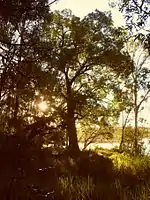 The Marriage Tree (Western Kurrajong Tree) given as a gift during an Aboriginal Marriage at Evans Head, New South Wales, Australia. (2010). In Bundjalung National Park at an Aboriginal midden on the banks of the Evans River, is a Western Kurrajong tree that is estimated to be more than 360 years old. The Marriage Tree as it is called by Bundjalung Aboriginals, was a gift from the Wahlubal tribe at Tabulam, when a wedding took place at Gummigurrah between a man and a woman. Gummigurrah was the winter campsite for Bundjalung people.The midden site is close to a camping ground. |
Details |
| May 1770 AD | Victoria Park Nature Reserve is a 17.5 hectare sub tropical jungle remnant of the Big Scrub which once covered most of the district, situated 16 kilometres south-east of Lismore, it features the remnants of a gigantic Moreton Bay Fig tree, which was seen by Lieutenant James Cook FRS RN as he sailed up the east coast of Australia on HMS Endeavour. The tree was struck by lightning in the early 1980s, but today people can walk around its base and marvel at its size. | Details |
| 15 May 1770 AD | 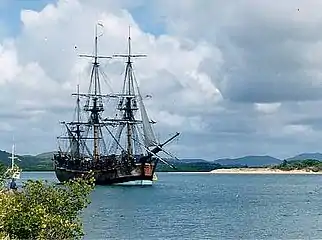 Endeavour replica crossing the Endeavour River at Cooktown, near where its namesake was beached for seven weeks in 1770 The coast in the vicinity of Evans Head was first mapped and described by Lieutenant James Cook FRS RN of the United Kingdom on HMS Endeavour. |
Details |
| 15 May 1770 AD | 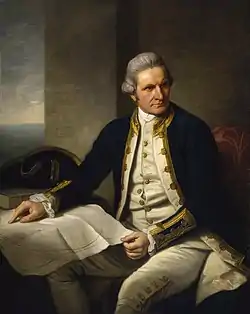 Lieutenant James Cook FRS RN (1775). Lieutenant James Cook FRS RN noted the presence of about 20 Bundjalung Nation Arakwal Aboriginal people on what is now known as 'Seven Mile Beach', north of Lennox Head and just to the south of Broken Head. |
Details |
| 15 May 1770 AD | 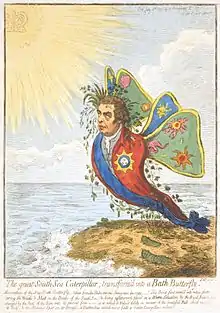 Caricature of 'Sir Joseph Banks' wearing the Order of the Bath as a result of his expedition to the South Seas. Sir Joseph Banks also noted the same 20 Bundjalung Nation Arakwal Aboriginal people as Lieutenant James Cook FRS RN, and he noted that: '... not one was once observed to stop and look toward the ship; they pursued their way in all appearance entirely unmoved by the neighbourhood of so remarkable an object as a ship must necessarily be to people who have never seen one.'[11] This would seem to indicate that HMS Endeavour was not the first ship that they had seen (Richmond River Historical Society {RRHS}, 1997). |
Details |
| 16 May 1770 AD | 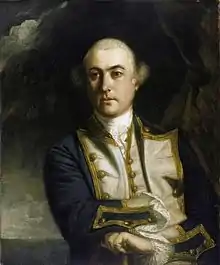 John Byron, by Joshua Reynolds, 1759 Lieutenant James Cook FRS RN on the Endeavour names Cape Byron, in honour of Vice-Admiral The Hon. John 'Foulweather Jack' Byron RN (8 November 1723 – 10 April 1786), another British navigator, and grandfather of Lord Byron (22 January 1788 – 19 April 1824). Cook also noted a pair of small islands, naming the two main peaks Julian Rocks after his nephew and niece, Juan and Julia. Lieutenant James Cook FRS RN, was the first European to record in his diary of seeing "… a remarkable sharp peaked Mountain lying inland…"[12] from a point of land he named Cape Byron. Just five hours later while sailing North, Cook was forced to change course to the East after encountering the dangerous reefs that run 3 miles (4.8 km) to the East from Fingal Head, now named Danger Reefs (comprising Inner, South, and Outer reefs).[13] |
Details |
| 17 May 1770 AD | 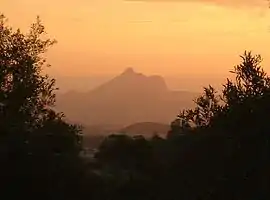 Mount Warning at sunset. Mount Warning (Wulambiny Momoli) was named by Lieutenant James Cook FRS RN as a warning to other seafarers, of the numerous treacherous reefs along the New South Wales north coast, after seeing the mountain from the sea while sailing past. Lieutenant James Cook FRS RN, did not know that the Bundjalung people for many miles around called the mountain 'Wulambiny Momoli', and that it was an important sacred site, as their lives and religion were strongly linked to the land. Lieutenant James Cook FRS RN on the Endeavour recorded in his diary in the morning:
|
Details |
| 20 August 1828 AD | 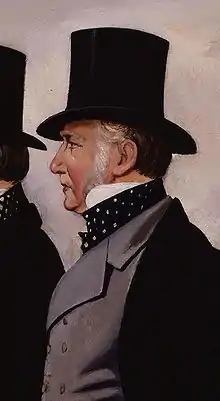 Portrait of 'Henry John Rous' with George Payne, by G. Thompson Captain Henry John Rous, also known as Admiral Henry John Rous (23 January 1795 – 19 June 1877), on the frigate HMS Rainbow dropped anchor at Byron Bay. His mission was to discover a navigable river and safe anchorage site. Rous identified the mouth of the Richmond river as he sailed along the coast from Sydney Town to Moreton Bay. |
Details |
| 26 August 1828 AD |  Captain Henry John Rous on the frigate HMS Rainbow discovers the entrance to the Richmond River (the longest navigable river on the coast of NSW) and explores 32 kilometres up the river with two lieutenants in a Pinnace, as far as Tuckean Swamp. Captain Henry John Rous subsequently named the river Richmond after his brother's best friend, Charles Gordon-Lennox, 5th Duke of Richmond. |
Details |
| 1839 AD |  Queen Victoria (Alexandrina Victoria; 24 May 1819 – 22 January 1901) was the Queen of the United Kingdom of Great Britain and Ireland from 20 June 1837, and the first Empress of India of the British Raj. "where there is a violent death in consequence of a collision with white men, an Inquest or Inquiry is to be held in the same way as if the Deceased had been of European origin". |
Details |
| 1839 AD | Originally, Tabulam and the surrounding farm and bushland was inhabited by Bundjalung Nation Aboriginal people. The land was first settled by Europeans in 1839. | Details |
| 1840 AD | 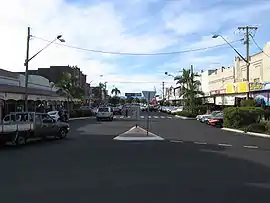 Walker Street shopping precinct in Casino. Squatters Henry Clay and George Stapleton cut a path through the bush from Glen Innes down to Tabulam, there they purchased cattle and drove their cattle herds over the Richmond Range and settled on the Richmond River. To their 30,720-acre (124.3 km2) grazing run they claimed, they gave the name "Cassino" (Now known as the town of Casino) which was named after the beautiful town of Monte Cassino in Italy. Prior to European settlement the Casino district was part of the lands inhabited by the Bundjalung Aborigines. It is unclear how many of the group lived around Casino although one report, dating from 1840, talks about a gathering of a 'mob of wild blacks numbering five hundred or upwards'. The Bundjalung spread across the area and their territory reached as far north as Toowoomba and included the modern-day towns of Tenterfield and Warwick. One of the annual rituals of the Bundjalung people was the movement to the coast during the winter months when the mullet were plentiful. The inland peoples from around Casino brought black bean seeds with them to trade for the fish. The seeds are poisonous, but become edible when carefully prepared by pounding into flour, leaching with water, and roasting. The timber, which somewhat resembles walnut, is soft, fine-grained, and takes a good polish, but is not durable. The Black Bean or Moreton Bay Chestnut (Castanospermum australe) has proved valuable to Europeans as a timber species, its seeds have been utilised – following extensive preparation as a food by Aborigines and it contains alkaloids which have been shown to have anti-HIV and anti-cancer properties.[14] |
Details |
| 1841 AD |
On 11 August 1841 Oliver Fry was appointed the first commissioner of Crown Lands for the Clarence Squatting District, incorporating the Clarence, Richmond and Tweed Valleys. It was his decision not to officially record Aboriginal culture of the region. Fry was instructed to 'gain confidence and goodwill' of the Bundjalung Nation Aboriginals in the 'pursuit of civilised life', and he was involved in at least one known massacre of Dangaddi or Gumbainggari aboriginal people in 1845, in the Boyd River Region of Oxley Wild Rivers National Park, along the Old Glen Innes to Grafton Highway in North East NSW. It is said that the Clarence River Aboriginals in their primitive state were remarkably moral, and most rigid in the observance of their marriage and other laws. |
Details |
| 1842 AD | The beginning of European settlement into the Richmond River area by Red Cedar cutters (lumbermen) and farmers (pastoralists).
 Tea Tree Oil (Melaleuca Oil) This initial establishment of European settlement and associated industries in this harsh environment was foreign to early European settlers. High rainfall and humid conditions, injuries and insect attack was a major health hazard causing serious infection that may result in death. Supplies of mild European antiseptics were scarce and had limited effect on serious infections and fungal diseases. The indigenous native Bundjalung Nation Aboriginals of eastern Australia exposed to the same harsh conditions with little or no protection were observed crushing tea tree leaf and binding it over wounds and infections with paper bark strapping. The results were staggering, infection was controlled and wounds healed rapidly. Botanists soon identified this unique medicinal tree and created the botanical species Melaleuca alternifolia. In addition, the indigenous native Bundjalung Nation Aboriginal people used "tea trees" as a traditional medicine by inhaling the oils from the crushed leaves to treat coughs and colds. Furthermore, tea tree leaves are soaked to make an infusion to treat sore throats or skin ailments. Historically ‘Bungawalbyn Valley Basin’ is the birthplace of the 'TEA TREE INDUSTRY' and over a period of time world populations were introduced to this unique 'natural' antiseptic. Still to this day, modern science has failed to provide a safe effective medication for the treatment of topical infections and fungal diseases compared to ‘Australian Native Tea Tree Oil'.[15] |
Details |
| 1842 AD | PELICAN CREEK TRAGEDY: In 1842, five European men were killed at Pelican Creek which is a few kilometres north of Coraki, which lead to 100 Bundjalung Nation Aboriginal tribes people being massacred by way of reprisal at Evans Head. | Details |
| 1842 AD | EVANS HEAD MASSACRE: The Evans Head Massacre which led to the deaths of approximately 100 Bundjalung Nation tribes people by Europeans at Evans Head, was said by Aboriginals to have been in retaliation for the killing of 'a few sheep', or was said by Europeans to have been for the killing of 'five European men' from the 1842 'Pelican Creek Tragedy'. | Details |
| 1843 AD |
Surveyor James Burnett named the new settlement at the mouth of the Richmond River 'Deptford' (Now known as the town of Ballina). |
Details |
| 1843 AD |  The Rainbow Train in Heritage Park in Lismore. European History of Lismore begins in c.1843. The original sheep run in what is now the Lismore area was located on the north arm of the Richmond River, and the station covered 23,000 acres (93 km2), taken up by Captain Dumaresq around 1843. The sheep which were herded down from New England found the wetter sub-tropical climate not to their liking, and the losses caused by fluke, foot rot and other diseases led to the abandonment of the run. In January 1845, William and Jane Wilson took over the run, and named it Lismore, after a small island in a loch in the Scottish Highlands. They built a house at the far northern corner of the run within twelve months of arrival, and a second house by 1851 near the corner of the present Ballina and Molesworth Streets, which was known as Lismore House. Unfortunately, neither house survives. The Wilsons, however, were commemorated in 1976 by the renaming of the north arm of the Richmond River as Wilson River. |
Details |
| 1849 AD |  Welcome sign on the outskirts of Coraki. The village of Coraki was founded by William Yabsley. |
Details |
| 1853/4 AD | EAST BALLINA MASSACRE: The Native Mounted Police were formed in 1848 in New South Wales. The Mounted Police members were from subdued Aboriginal tribes and were under the command of European Officers. The Native Mounted Police enforced European law on Aboriginal tribes with which they had no bonds.
In 1853–4, at an area close to the present day East Ballina Golf Course, the Native Police slaughtered at least 30 – 40 Bundjalung Nation Nyangbal Aboriginal men, women and children while they slept.[1][2] It was believed by Native Mounted Police that some Aborigines from north of the Tweed River had murdered some Europeans and that the murderers had fled south towards the Richmond River. On the night prior to the raid, the Mounted Police stayed at James Ainsworth's father's Public House, 'The Sailor's Home'. That is, the European troopers stayed in the Hotel while the native Aboriginal trackers stayed outside the Hotel. The Native Mounted Police patrol neither disclosed the purpose of their mission nor made any inquiries about the incident. At 3 am the next morning the Native Mounted Police patrol rode out to where between 200 and 300 Bundjalung Nation Nyangbal Aboriginal tribes people lay asleep in camp. The Nyangbal East Ballina clan had a camping ground on the slope of the hill facing the valley near Black Head. The troopers and trackers surrounded the Bundjalung Nation Nyangbal Aboriginal camp and opened fire at close range. Aboriginal men, women and children of the Bundjalung Nation Nyangbal East Ballina clan were slaughtered. After the carnage, the Native Mounted Police patrol then headed north towards the Tweed River. The European settlers of East Ballina were disturbed by the unprovoked attack on the friendly natives. They reported the massacre to the NSW Government and urged it to take action. The NSW Government took no action against the perpetrators and told the Europeans settlers ‘to mind their own business and warned that persistence in the matter might lead to trouble for them', hence there are no official records of the massacres. When the Aboriginal survivors eventually returned to the camp, they sought no reprisals and took no revenge against the Native Mounted Police involved in the massacre.[16] There is also strong oral tradition amongst the Bundjalung Aboriginal community that a massacre occurred in the 1850s at an old campsite at East Ballina. The oral tradition includes stories of escape, of people who were shot and were laid to rest in the forests north of the camp, and of those who were driven off the cliff at Black Head. There is a belief that some victims of the massacre were never buried, their bodies being either dumped off the cliff at Black Head or abandoned on Angels Beach.[17] |
Details |
| 1860s AD | SOUTH BALLINA POISONING: The South Ballina clan of the Nyangbal people were a tribe, sub-group or estate group of the Bundjalung Nation, numbering about 200 people during the early development of Ballina township.[1][2] During the early 1860s a mass poison attempt was made. Poisoned flour was given to the Bundjalung Nation Nyangbal Aboriginal people to make damper. The Nyangbal Aboriginal people took it to their camp at South Ballina for preparation & cooking. The old people and children of the Nyangbal tribe refused to eat the damper as it was a new food. Upon waking the next morning, survivors of the Nyangbal[1] l tribe found nearly 150 adults dead.[16] | Details |
| 1882 AD | New Italy Settlement: Perhaps the most interesting of all the developments around the town of Rocky Mouth (now called Woodburn by European Settlers and was known by Bundjalung Aboriginals as 'Maniworkan') occurred in 1882 when a number of Italians settled near Woodburn. 'In 1880, the ill-fated Marquis de Rays expedition of 340 hopeful migrants from Veneto, Italy, sailed to make a new home in New Ireland (now part of Papua New Guinea).
'Here they struggled against fever, starvation and the jungle, and many died. After four months the survivors made their way to Noumea and sought aid from the Government of New South Wales. The Premier, Sir Henry Parkes, arranged their safe transport. They reached Sydney on 7 April 1881. A number of them came to this place and built a happy and prosperous settlement, which was called "New Italy". Nothing now remains of their homes. But the quiet pride, the courage and strength of these Italian pioneers will always be remembered in the Woodburn district with respect and gratitude.' |
Details |
| 1877 AD | Discovery of gold at Evans Head. | Details |
| 1928 AD | Sir Charles Edward Kingsford Smith in his plane, the "Southern Cross", was the first person in an aircraft to cross the Pacific from Oakland California to Brisbane QLD, via Honolulu, Suva and Ballina. Charles Kingsford Smith and Charles Ulm covered the 7,200 miles (11,600 km) in 83 hours 50 minutes flying time from 31 May – 9 Jun 1928. | Details |
| 1954 AD | 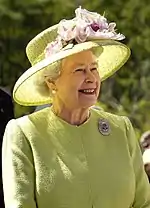 Her Australian Majesty Queen Elizabeth II (2007). Her Australian Majesty Queen Elizabeth II visited Evans Head during her Royal visit to Australia. |
Details |
| 1968 AD |
Before 1968 it was illegal to pay an indigenous worker more than a specified amount in goods or money. They were not allowed to own land and any currency or money they earned was administered on their behalf by whites. In many cases, the government benefits for which Indigenous employees were eligible were paid into pastoral companies’ accounts, rather than to the individuals. Aboriginals were stopped from raising their own children, from freedom of movement, having access to education, receiving award wages, marrying without permission, eating in restaurants, entering a pub, swimming in a public pool or having the right to vote. |
Details |
| 1973 AD |  Las Balsas raft – original sail design by Salvador Dali. The Las Balsas rafts were towed into Ballina by fishing trawlers after their journey from Ecuador. They originally had planned to arrive in Mooloolaba in Queensland, but currents had forced them off their destination. Their journey was almost twice as long as the Kon-Tiki expeditions of 1947 and proved that people could have travelled across the Pacific in ancient times. |
Details |
| 1976 AD | The Aboriginal culture in the Bundjalung Nation is evident in many aspects, including many bora rings. Casino was an important aboriginal meeting place. A bora ring more than twice the diameter of the average ring was found just north of the town. However, the site was illegally destroyed by Pedrini for landfill at the Casino Hospital site in 1976. | Details |
| 1983 AD |
The NSW Land Rights Act 1983 was another important milestone. The dispossession of Aboriginal people from their land is acknowledged in the Act's preamble, which states; 1. Land in the State of New South Wales was traditionally owned and occupied by Aborigines. 2. Land is of spiritual, social, cultural and economic importance to Aborigines; 3. It is fitting to acknowledge the importance which land has for Aborigines and the need for Aborigines of land. 4. It is accepted that as a result of past government decisions the amount of land set aside for Aborigines has been progressively reduced without compensation. |
Details |
| 1985 AD | 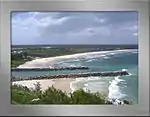 Goanna Headland at Evans Head, New South Wales, Australia. (2005). A 16 hectare section of the southern part of Goanna Headland at Evans Head became the first aboriginal land grant in New South Wales. |
Details |
See also
- Australian frontier wars | Australian megafauna | Bandjalang language | Bundjalung people | Commercialization of traditional medicines | Dirawong | History wars | Lists of legendary creatures | List of massacres of Indigenous Australians | List of Australian place names of Aboriginal origin | Animal worship | Caledonian Confederacy | Comparative linguistics | Demiurge | Dreaming (spirituality) | Land rights | Limes (Roman Empire) | Noongar | Noongar | Philology | Living Tongues Institute for Endangered Languages | Three Sisters (Australia) | The Three Sisters (Queensland) | Yagan
References
- Ballina City Council
- National Parks and Wildlife Service
- "Australia - Aboriginal Mythology". Janesoceania.com. 31 May 2012. Retrieved 10 March 2015.
- "National Native Title Tribunal : Githabul People's native title determination" (PDF). Web.archive.org. Archived from the original (PDF) on 1 June 2011. Retrieved 10 March 2015.
- Mount Warning#Etymology
- Archived 24 October 2009 at the Wayback Machine
- "Kendall : The Birpai". Web.archive.org. Archived from the original on 13 October 2009. Retrieved 10 March 2015.
- "jindawallanews". Freepages.history.rootsweb.ancestry.com. Retrieved 10 March 2015.
- "BalliGenWeb > Stories > Ballina". Rootsweb.ancestry.com. 23 November 1956. Retrieved 10 March 2015.
- "Cook's Journal: Daily Entries, 16 May 1770". Southseas.nla.gov.au. Retrieved 10 March 2015.
- Australian Hydrographic Chart "AUS 813"
- "briefhistorycasino". Rootsweb.ancestry.com. Retrieved 10 March 2015.
- "Zandella.com". Zandella.com. Retrieved 10 March 2015.
- "Wollumbin Dowsing". Web.archive.org. 29 January 2010. Archived from the original on 29 January 2010. Retrieved 10 March 2015.
- "Living on the frontier | NSW Environment & Heritage". Environment.nsw.gov.au. Retrieved 10 March 2015.
